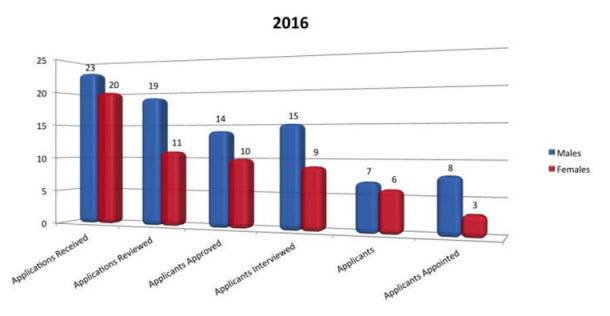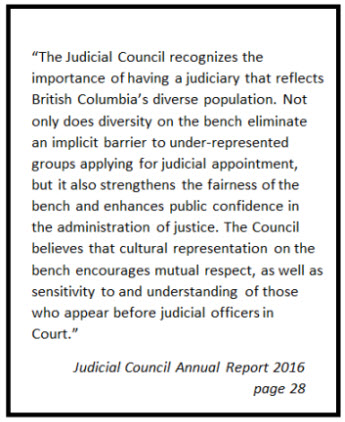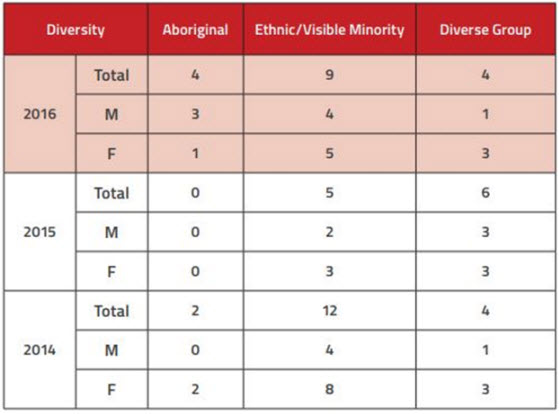Recognized for its leadership in providing transparency and accountability in the judicial appointment process, BC’s Judicial Council has released its 20th Annual Report. Again this year, the Report includes statistics on applicants for judicial appointments to the British Columbia Provincial Court and their demographics – gender, age, experience, residential region, and ethnic background.
This eNews provides highlights from the BC Judicial Council’s 2016 Annual Report.
The Provincial Court Act establishes the membership of BC’s Judicial Council: three judges, two lawyers (representing the Law Society of BC and the Canadian Bar Association BC Branch) and up to four other people appointed by the Attorney General of the province. In 2016 these were the CEO of Family Services of Greater Vancouver, a retired police officer with experience on immigration and refugee boards, a retired judicial justice, and a practising lawyer.
In Canada, judges are appointed to provincial courts by the province’s Lieutenant Governor in Council (the Lieutenant Governor acting on the advice of the provincial Cabinet). The BC Judicial Council’s primary responsibility is to screen and recommend qualified candidates for judicial office. The provincial Attorney General selects from the candidates approved by Judicial Council and makes recommendations to Cabinet for appointments.
The Judicial Council has established criteria and competencies for Provincial Court judicial appointments that include exceptional professional qualifications, temperament, ability and community standing. In order to ensure a high standard, the Council requires lawyers seeking appointment to submit detailed applications, and it examines investigations conducted by the BC Branch of the Canadian Bar Association and the Law Society of BC. It also solicits comments from judges and people who have worked with the applicant, including non-lawyers. Following a successful review of the application, the Council will interview and recommend the most capable candidates to the Attorney General.
In 2016, the Council received 43 applications for appointment as a Provincial Court Judge (an increase from 27 the previous year). Including applications carried forward from 2015, the Council reviewed 30 applications for appointment as a Judge, interviewed 24 applicants and recommended 13 for the bench in 2016. It also reviewed applications for appointment as a Judicial Justice, Justice of the Peace Adjudicator and Justice of the Peace.
BC’s Judicial Council is committed to making the application process as transparent as possible. In 2013 the Canadian Bar Association recognized it as a model of transparency for its leadership in publishing applicants’ statistics.
Applicants’ Gender
According to the Law Society of BC’s 2016 Report on Performance, women make up 39 per cent of the provincial legal profession. In the last two years, equal numbers of women and men have become BC lawyers. According to the Court’s 2015/16 Annual Report, as of March 31, 2016 40 per cent of full-time Judges were female. The proportion of female Judges appointed to the Provincial Court has increased in recent years and is approaching parity with males.

Male and Female Applicants
In 2016, the Judicial Council received 20 applications from women (the ten-year average was 19.8) and 23 from men (the ten-year average was 30.1). Although the number of female applicants reviewed in 2016 was lower than average, the number of females approved for interviews, interviewed, recommended, and appointed, equalled the 10-year average. In 2016 the Council recommended six women and seven men for appointment. In 2015, more women were appointed to the bench than men; however, in 2016 the Lieutenant Governor in Council appointed three women and eight men from the list of approved applicants, which included 23 applicants recommended in previous years (11 men and 12 women).

Cultural diversity
Judicial Council is committed to encouraging applications from candidates of diverse backgrounds. In 2013 it amended its application forms to invite applicants to include, on a voluntary basis, their ethnic or cultural information. In 2014, 18 out of 50 applicants answered the form’s new questions. In 2015, 11 of 26 applicants volunteered information on their ethnic or cultural backgrounds.
In 2016, 17 of 43 applicants provided information on their ethnic or cultural backgrounds. Four were of Aboriginal heritage, nine indicated an ethnic or visible minority background, and four identified themselves as being part of a diverse group. For a list of the visible minority and diverse groups identified, see the report at page 28.
The Judicial Council reports it will continue to review and revise its processes to encourage a wide cultural range of applicants and to make merit-based recommendations that reflect the diversity of British Columbia’s population.

Diversity Responses in Judicial Applications (2014–2016)
Age and experience
The average age of applicants to the Provincial Court in 2016 remained 52 years (52.9 for men and 50 for women). Applicants in 2016 had an average of 22 years in the practice of law (24 years for men and 20 years for women). This is slightly higher than the ten-year average. Applicants to the Court came from all regions of the province and from various fields – 62% from private practice, 29% from Crown Counsel, and 9 % from other types of legal work, in 2016.
Other topics
The Council commenced a process to move from hard copy applications for judicial appointments to electronic, online application forms last year, and that transition will take place on September 5, 2017, making the BC Provincial Court the first in Canada to use technology in this way.
Judicial Council is also responsible for overseeing the delivery of education for judicial officers; and when necessary, undertaking inquiries into the conduct of judicial officers. No inquiries were held in 2016.
Judicial Council’s 2016 Annual Report continues the Council’s tradition of accountability, transparency and public access to information. It provides much more detailed statistics on the matters featured here, often using colourful graphs. You’ll find it, and previous reports, on the Judicial Council page of the Provincial Court website, www.provincialcourt.bc.ca.

